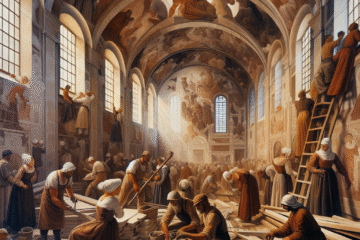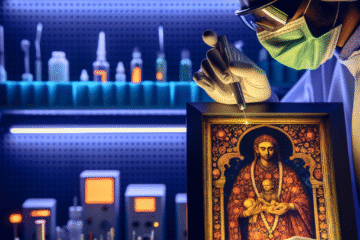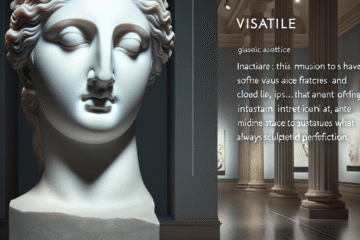I. Introduction
The Baroque period in art was a time of great creativity and expression. Spanning from the late 16th century to the early 18th century, the Baroque era was marked by an exuberant and grandiose style of art that reflected the tumultuous times of the period. In this article, we will delve into the definition of the Baroque period, provide an overview of the historical context during the era, explain the exuberant and grandiose style of Baroque art, and briefly mention some of the most famous Baroque artists.
A. Definition of the Baroque Period
The term “Baroque” comes from the Portuguese word “barroco,” meaning “misshapen pearl.” The term was first used to describe the highly ornate and elaborate art and architecture of the 17th century. During this time, artists and architects broke away from the classical symmetry and balance of the Renaissance, creating works that were full of drama, movement, and emotion.
B. Overview of the Historical Context during the Baroque Era
The Baroque period was a time of great upheaval and change in Europe. The continent was torn apart by religious wars and political turmoil, and artists reflected these tensions in their works. The Catholic Church, which was undergoing its own reforms, also played a major role in commissioning works of art and architecture to propagate its messages. At the same time, the growth of global trade and colonization brought new ideas and influences to Europe, fueling the creativity and imagination of artists.
C. Explanation of the Exuberant and Grandiose Style of Baroque Art
Baroque art is characterized by its emphasis on drama, movement, and emotion. Artists used light and shadow to create illusion and depth, and incorporated intricate and ornate design elements into their works. Unlike the classical balance and symmetry of the Renaissance, Baroque art is characterized by its asymmetrical and irregular forms. The works of Baroque artists are often grandiose, expressing power and opulence through their size and intricate details.
D. Brief Mention of the Most Famous Baroque Artists
Some of the most famous Baroque artists include Caravaggio, Bernini, Velázquez, Rubens, and Rembrandt. Caravaggio is known for his dramatic use of chiaroscuro, or light and shadow, to create powerful emotional scenes. Bernini was a sculptor and architect who created some of the most famous sculptures and fountains of the Baroque era, including “The Ecstasy of St. Teresa.” Velázquez was a court painter in Spain who is known for his portraits, including the famous “Las Meninas.” Rubens was a Flemish painter who is famous for his lush and colorful paintings, including “The Descent from the Cross.” Finally, Rembrandt was a Dutch master who is known for his portraits and historical scenes, including the famous “Night Watch.”
The Baroque period was a time of great creativity and expression, producing some of the most famous works of art in history. From its exuberant and grandiose style to its historical and cultural significance, the Baroque era continues to inspire and influence artists to this day.
II. Characteristics of Baroque Art
The Baroque period in art was characterized by a dramatic and emotional style that broke away from the classical balance and symmetry of the Renaissance. In this section, we will explore some of the key characteristics of Baroque art, including its emphasis on drama, movement, and emotion, its use of light and shadow, its extravagant and ornate design elements, and its rejection of Renaissance symmetry and balance.
A. Emphasis on Drama, Movement, and Emotion
Baroque art is marked by its emphasis on drama, movement, and emotion. Artists used light and shadow, dramatic poses, and dramatic scenes to create works that were full of energy and emotion. For example, Caravaggio’s paintings are known for their powerful and emotional scenes, often featuring intense moments of light and shadow. This emphasis on drama, movement, and emotion set Baroque art apart from the calm and balanced style of the Renaissance.
B. Use of Light and Shadow to Create Illusion and Depth
Baroque artists also made use of light and shadow to create illusion and depth in their works. By playing with light and shadow, they were able to create the illusion of three-dimensional space on a two-dimensional surface. For example, Caravaggio’s use of chiaroscuro, or light and shadow, gave his paintings a dramatic and intense quality that was unparalleled in his time.
C. Extravagant and Ornate Design Elements
Baroque art is also characterized by its extravagant and ornate design elements. Artists used elaborate designs and intricate details to create works that were grandiose and opulent. For example, the sculptures of Gianlorenzo Bernini are known for their intricate details and ornate designs, often incorporating elements of nature, such as leaves and vines, into their works.
D. Rejection of Renaissance Symmetry and Balance
Finally, Baroque art rejected the symmetry and balance that was favored in the Renaissance. Instead, Baroque artists created works that were asymmetrical and irregular, with a focus on movement and drama. For example, Bernini’s sculptures are often characterized by their dynamic poses and fluid lines, breaking away from the classical balance of the Renaissance.
In conclusion, the Baroque period in art was characterized by a dramatic and emotional style that broke away from the classical balance and symmetry of the Renaissance. With its emphasis on drama, movement, and emotion, its use of light and shadow, its extravagant and ornate design elements, and its rejection of Renaissance symmetry and balance, Baroque art remains a fascinating and enduring style to this day.
III. Notable Baroque Masterpieces
The Baroque period in art produced some of the most remarkable masterpieces in the history of Western art. In this section, we will take a closer look at some of the most notable Baroque masterpieces, including Caravaggio’s “The Calling of St. Matthew,” Bernini’s “The Ecstasy of St. Teresa,” Velázquez’s “Las Meninas,” Rubens’ “The Descent from the Cross,” and Rembrandt’s “Night Watch.”
A. Caravaggio’s “The Calling of St. Matthew”
Caravaggio’s “The Calling of St. Matthew” is one of the most famous Baroque paintings, and is considered a masterpiece of the genre. This painting depicts the moment when Jesus calls Matthew to follow him and become one of his disciples. Caravaggio’s use of light and shadow creates a dramatic and intense scene, with the bright light of Jesus casting a deep shadow over the figures in the foreground. This painting is a powerful example of Caravaggio’s dramatic and emotional style, and is considered one of the greatest masterpieces of the Baroque period.
B. Bernini’s “The Ecstasy of St. Teresa”
Bernini’s “The Ecstasy of St. Teresa” is a breathtaking sculpture that depicts the saint in a moment of spiritual rapture. This work is considered one of Bernini’s greatest masterpieces, and is renowned for its intricate details and ornate design. The intricate details of the clouds, wings, and angel’s hair are a testament to Bernini’s skill as a sculptor, and the dynamic pose of St. Teresa is a perfect example of the Baroque focus on movement and drama.
C. Velázquez’s “Las Meninas”
Velázquez’s “Las Meninas” is one of the most famous paintings of the Baroque period, and is considered a masterpiece of the genre. This painting depicts a scene from the court of King Philip IV of Spain, with the princess, her ladies-in-waiting, and the king and queen in the background. Velázquez’s use of light and shadow creates a dramatic and intense scene, and his technique of painting himself into the scene is a revolutionary moment in the history of Western art.
D. Rubens’ “The Descent from the Cross”
Rubens’ “The Descent from the Cross” is a powerful painting that depicts the moment when Jesus is taken down from the cross after his crucifixion. This work is considered one of Rubens’ greatest masterpieces, and is renowned for its dramatic and emotional style. The painting is characterized by its rich colors and dramatic poses, and is a testament to Rubens’ skill as a painter.
E. Rembrandt’s “Night Watch”
Rembrandt’s “Night Watch” is one of the most famous paintings of the Baroque period, and is considered a masterpiece of the genre. This painting depicts a group of civic guards on the night watch, and is characterized by its use of light and shadow to create a dramatic and intense scene. Rembrandt’s use of light and shadow gives the figures in the painting a three-dimensional quality, and his use of color is considered one of the defining characteristics of his style.
In conclusion, the Baroque period in art produced some of the most remarkable masterpieces in the history of Western art. From Caravaggio’s “The Calling of St. Matthew” to Rembrandt’s “Night Watch,” these works are a testament to the exuberant and grandiose style of Baroque art. Whether it’s the dramatic use of light and shadow, the intricate details of the sculptures, or the ornate design elements in the paintings, these works are a testament to the skill and creativity of the artists who created them. These masterpieces continue to inspire artists and art lovers alike, and are considered some of the greatest works of art in the world. The Baroque period in art was a time of great artistic innovation and experimentation, and these masterpieces are a testament to the incredible artistic achievements of this era.
IV. Influence of the Baroque on Art and Culture
The Baroque period in art had a profound and lasting influence on art and culture in Europe and beyond. One of the most notable ways in which the Baroque era influenced the art world was through its impact on the development of other art movements. The ornate, grandiose style of Baroque art was the starting point for the creation of the Rococo style, which emerged in the late 1600s and early 1700s. Rococo art was characterized by its light, airy style, and its emphasis on beauty and elegance, and it was heavily influenced by the elaborate and ornate design elements of Baroque art.
Another way in which the Baroque era influenced the art world was through its role in propagating political and religious messages. Many Baroque masterpieces were created as propaganda, designed to spread the message of the Catholic Church or the ruling monarchy. These works of art often depicted religious or political figures in a grandiose and exuberant manner, designed to convey a sense of power and authority. In this way, Baroque art was an important tool for shaping public opinion and reinforcing the values of the ruling elite.
Finally, the Baroque period had a profound impact on the development of European cultural identity. Many of the masterpieces created during this era are now considered to be defining works of art, and they have come to symbolize the culture and history of Europe. These works are treasured not only for their aesthetic value, but also for their cultural significance, and they continue to play an important role in shaping our understanding of European art and culture.
In conclusion, the Baroque period in art was a time of great creativity and innovation, and its impact on art and culture continues to be felt today. From the development of other art movements, to its role in propagating political and religious messages, to its importance in shaping European cultural identity, the Baroque era will always be remembered as one of the most significant and influential periods in the history of art.
V. Conclusion
In conclusion, the Baroque period was a time of great artistic creativity and innovation, and its impact on the art world continues to be felt to this day. This era was characterized by its emphasis on drama, movement, and emotion, its use of light and shadow to create illusion and depth, and its extravagant and ornate design elements. Some of the most famous Baroque masterpieces include Caravaggio’s “The Calling of St. Matthew,” Bernini’s “The Ecstasy of St. Teresa,” Velázquez’s “Las Meninas,” Rubens’ “The Descent from the Cross,” and Rembrandt’s “Night Watch.”
The Baroque era had a profound and lasting influence on art and culture, from its impact on the development of other art movements, such as Rococo, to its role in propagating political and religious messages, to its importance in shaping European cultural identity. These works of art continue to be treasured not only for their aesthetic value, but also for their cultural significance, and they play an important role in shaping our understanding of European art and culture.
In conclusion, Baroque masterpieces are a testament to the incredible artistic achievements of this era, and they will always be remembered as some of the most significant and influential works of art in the history of art. Whether one appreciates the dramatic, emotive quality of the paintings, the intricate details of the sculptures, or the ornate design elements in the paintings, these works are a true reflection of the talent and creativity of the artists who created them. To truly appreciate the significance of Baroque art, one must understand its historical context, its artistic characteristics, and its lasting impact on contemporary art and culture.


